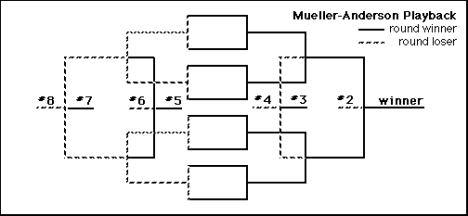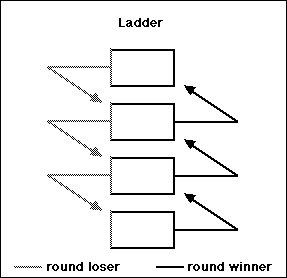In light of the four points mentioned earlier, the single
eliminator is superior in terms of time management and can produce an
undisputed winner in one fewer races than there are racers (see the above
diagram, 8 racers, 7 races). Due to its simplicity, its entertainment value
is also great -- even a child can understand it. The pairings are fair, too,
in an ethical way if not an entertaining way. The shortcomings of the single
eliminator start to become evident here. Everybody has been to a race where
the match ups themselves all but predetermined the winners. Going back to
the NCAA "March Madness" example, no #16 team has EVER beat a #1
team. (It doesn't seem to have hurt the NCAA tourney all that much except
that first round TV viewership isn't all that great.)
The place where the single eliminator really has a weakness is in the level
of participation it gives each racer. Half of the racers get to only make
one lap and 75% of them only get to make two. One of the hallmarks of
professionalism is a total focus on winning (as opposed to a focus on
participating) which makes the single eliminator the most professional
tournament structure of all. This is why at youth sports tournaments, the
single eliminator is seldom used since the parents want a chance for their
child to participate more than they want their child to win all the
time.
There is a direct correlation here to amateur drag racing
in that, to many participants, it is unacceptable to lose in the first round
of a single elimination event. They wanted to make a day of it but are
brought up short. All their preparation, travel time, etc., to participate
in their hobby is over in short order.
Because of their great desire to continue, they are
vulnerable to participating in an aberration of the single eliminator known
as "the buy-back", a system where the racer can repay their entry
fee (or some fraction thereof) to buy their way back into the next round of
competition, thus avoiding elimination. This seriously compromises the
elimination system because instead of eliminating opponents, all that is
eliminated is money from the loser's wallet. This would be considered the
ultimate in bad taste in most other arenas. There are plenty of other
systems which could be used in order to give every competitor more seat time
and a legitimate second chance.
The simple consolation race
This is really just a second single eliminator held between the first round
losers of the scheduled event in an effort to give them a chance at making
more than one pass. This is different from the buy-back in that the losers
truly have been eliminated from the main event competition. Usually, winners
of the later rounds of the primary race are not included here primarily
because they have already had a chance to make more than one run and also by
using the losers from only the first round, the number of rounds for the
consolation race is virtually cut in half compared to allowing all the round
losers from the primary race from entering as they become available.
Wouldn't it be great to find a system where you could keep competing in the
main event and still be using a system with integrity?
Mueller-Anderson Playback (1)

This structure has so many advantages it is simply amazing
that no one uses it. The entire race is run with only 50% more heats than
the single eliminator but does not affect the number of rounds. As long as
you keep winning, it works just like a single eliminator but while you
eliminate others from the path between you and the winner position, they are
not eliminated from further competition because at every level, both the
winners and the losers race each other to determine the finish positions
behind the winner. In the eight car field shown in the diagram, only a total
of 12 races are run but each racer makes three laps and at the end of it
all, you can place each racer accurately in their finish position.
Although the diagram looks a little strange at first, and
would take a little effort to make up for a lot of entries, you can see
where this system is great especially if your club has a track rented for
the day and everyone wants to compete but also wants to make several passes.
While this isn't the most professional system, it isn't the least
professional either, and represents a great way for everyone to get multiple
laps in, provides the spectator several chances to watch their favorite
driver, provides great match-ups especially in later rounds, and does it all
in the same number of rounds as a single eliminator.
Match racing
The match race is usually thought of in terms of a booked in show where two
racers race for best 2 out of 3, but this structure can be applied to races
with large entry lists as well. The
Pure Stock Muscle Car Drag Race is one race that operates a 100+ car
field on this system with everybody going two or three rounds of racing. The
pairing is done by the promoter and is based on qualifying times. The
disadvantage is that there is no single winner of the race. The advantage is
that half the people go home as winners.
You may be tempted to think at this point that it isn't
very professional to give the loser so many chances to come back, or in
other words, to not eliminate them with the first win. In professional
sports however, the entertainment factor rises to the surface and for that
sake alone, this is often the structure of choice. Consider the world series
(baseball) with its seven games. Would anyone really want that to be a one
game deal?
The "Chicago style" race
Bill Pratt detailed the nuances of "Chicago style" racing which
you can read on the 7/16/00 Draglist Story of the Day, Chicago Style Drags
and Match Races. I can't add anything to Bill's great description there so
rather than quote him at length, you'd be better off to just go
there and read it all.
The ladder (2)

A great system for sportsman racing is a structure simply called the ladder.
The advantage is that everybody races the same number of rounds (whatever
number is picked in advance or there is time for) and there are virtually no
byes. The disadvantage is that the contestants have to make a paradigm shift
in their thinking away from "did I win the race?" to "how
many rounds did I win?" In the first round, the #1 qualifier is paired
with the #2 qualifier, the #3 vs. #4, #5 vs. #6, and so on to the end of the
entries. The winner of each pair moves up for the next round to race the
loser of the pair just above them on the qualifying list. The losers of the
round drop back to race the winners of the heats just below. This way, the
winners keep moving up and the losers keep moving down.
This is especially suited to large groups of racers who
want to race heads-up and where the performance difference between each
qualifying position is small enough so as to make moving up the ladder
possible. If heads-up racing is what people will sit in the stands for, then
this provides it. One disadvantage though is that after several rounds, the
racing could stagnate with multiple rematches between the same competitors.
Test and tune, grudge racing
You know all about this. There is no structure really. Anybody runs who
wants to and as much as they want to and if they want to hang out in the
staging lanes waiting to line up with somebody special, well then, OK. If
they get to the end and say, "Well, I wasn't really racing," well,
OK then, too. Actually, there are many tracks with a profitable test and
tune night. Of note is Piedmont Dragway, who has a monthly event named the
Big Dog Shootout which really packs the joint.(3)
Of interest to the track and promoter is that no prize
money is needed. If there is any cash advantage to winning, it's usually
supplied by the losing driver as part of a gambling scenario. A final
thought: unless you count racers keeping track of the ETs of the other cars,
there is no qualifying in grudge racing. This makes running without the
clocks an interesting event in that people will be more prone to challenge
another driver out of boldness rather than by crunching data. This is as
loose and unstructured as it gets.
Time for a change?
Many people have speculated on the whopping success of stock car racing in
the USA and have wondered why drag racing has not been able to duplicate
this type of success in terms of spectator appeal. When you look at the
single elimination ladder as is used in all the top drag meets, you can see
that no matter who your favorite driver/car is, you only have a 50% chance
of seeing them perform more than once. What would happen to the success of
stock car racing if the fan only had a 50% chance of seeing their favorite
driver/car past the first lap? I don't know the answer here, but it has
always struck me as an advantage for the fans over there.
For the hobby racer whose expense of getting to the track
may greatly outweigh their expense of making additional passes, the single
eliminator certainly becomes a limiting factor to their week-end or
afternoon of fun. Several people I have talked to have given up drag racing
to pursue other forms of motorsports purely because of the "seat
time" issue. On both sides of the issue, professional and sportsmen, I
just thought it was worth a look at some of the other options.
Next time, we'll look at qualifying positions and the importance of where
they get placed into the show.
As always, I welcome your feedback.
Doug Dornbos
dornbos@aol.com
----------------------------------------------------------------
References:
1. Intramural-Recreational Sports: Programming and Administration (5th
edition) by Pat Mueller & John W. Reznik
2. Organizing Successful Tournaments (2nd edition) by John Byl.
3. Inside Motor Sports, May 2000, p.58, The Sandtrap: A Day at the Races.
Several, actually..., by Jon Paulette